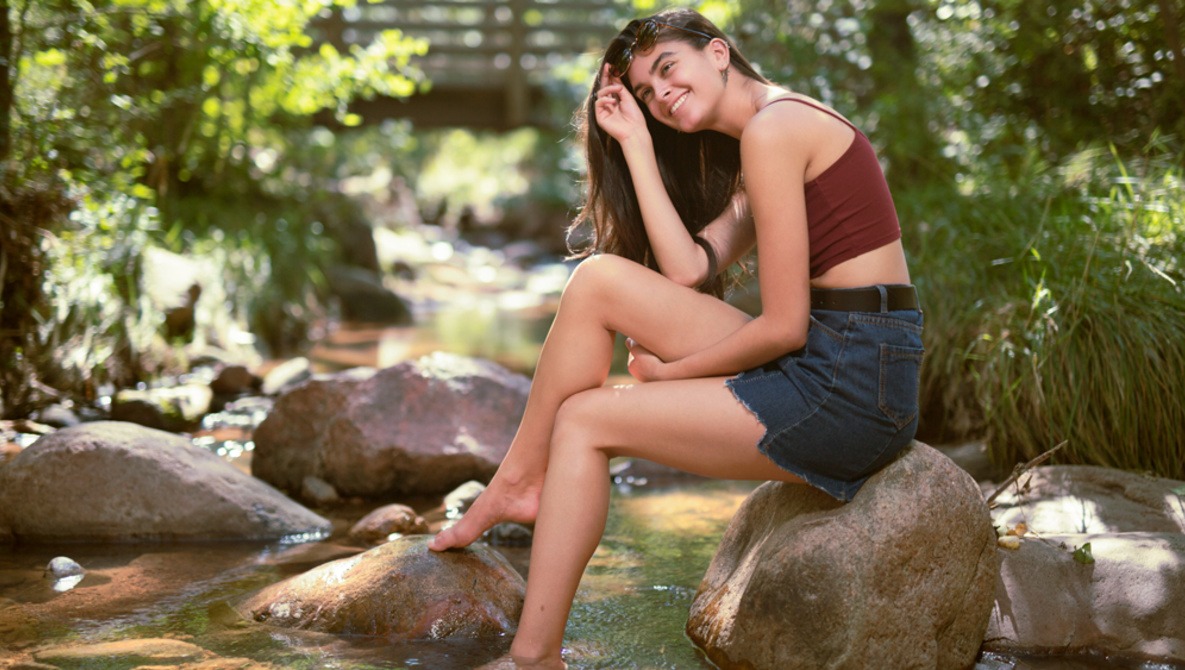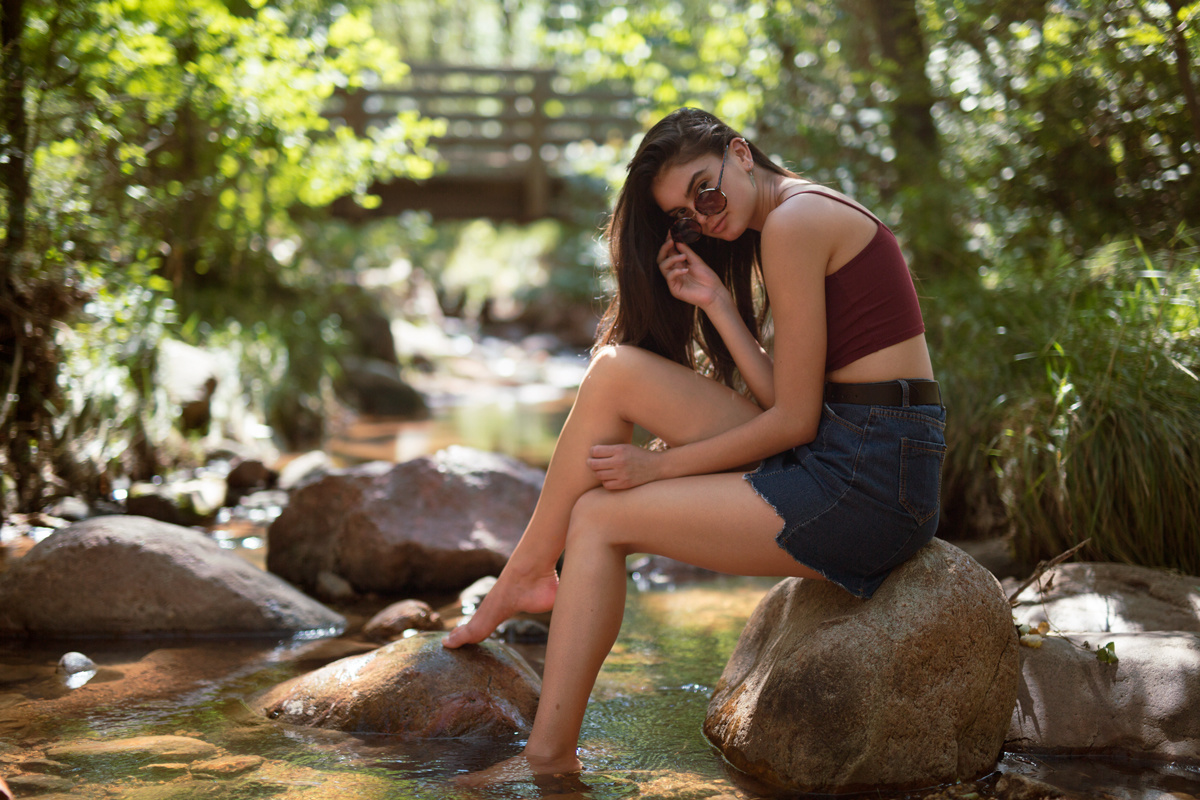In this week's lighting breakdown, I'm going to explain why and how I used a flash outdoors during midday to create this fun, casual portrait.
There are many ways to use a flash outdoors, but this time I wanted to focus on something that felt natural and easy. This pretty location has been on my list to photograph for a while, so I already knew I wanted to take advantage of the open shade, but I also wanted to shoot at a wide aperture to get of all the bokeh from the sunlight filtering through the trees.
Because it was near midday, it was far too bright to shoot at f/1.4 without making some kind of adjustment, like using high-speed sync, to keep the highlights from blowing. In this case, I decided to use an ND filter and a slower shutter speed to allow the ambient light to creep in.
Rather than have the flash very close to the model, which could have given away the light source by creating a more drastic fall-off, I wanted to place the light far enough back that it would be very broad and light the entire foreground just enough for a proper exposure. I didn't want the image to look "flashy."
In the before and after, you'll see what the shot looked like with, and without flash.
The flash, a Canon 580EX II fired through a Westcott Rapid Box, was situated as high as the light stand allowed and angled down toward the model in a manner similar to the natural sunlight. I would have preferred to place the light on the other side of the stream, but the steep bank on that side made that too risky to try without an assistant.

Canon 580 EXii, Westcott Rapid Box, and model Madison Flowers
After taking the shots, I checked to make sure the highlights were intact. I wanted to capture the image as close to natural as possible and retain that dynamic range as far as my equipment allowed.
I know some people might prefer to just underexpose and then compensate in post, but I prefer my images to be as close to finished as possible before I import them. Masking, worrying about artifacts in shadows that have been lightened, or having to spend too much time dodging and burning to enhance the light is something I'd rather not do if I don't have to. Because I wanted these photos to be all about the light when I shared them here, the edits were kept to cleaning up a few blemishes and warming up the tones to account for all the green reflected light.
I hope you're getting something out of this new series, and I'd love to hear whether you use setups like the ones shared in the “The Lighting Breakdown.”









"I know some people might prefer to just underexpose and then compensate in post, but I prefer my images to be as close to finished as possible before I import them."
A philosophy that causes you to lug around a bunch of extra gear resulting in that distinctly (some may say unpleasant) strobist look.
Are you saying lugging gear around is the strobist look? Or the final images? Cause when done right you wouldn't know if strobes are used.
The final result. The more natural the look, the more gear you have to carry. Even when gels are used, flash will never perfectly match the color of available natural light so you will have mismatches there that will reveal that strobes were used. Some people like that kind of look though.
I'll just have to disagree. I'm sure you'd be surprised how many photos have artificial light and you don't even realize it.
If there's an artificial vs. natural light challenge I'd be glad to take it.
Why is it always a question of either or? This isn't about whether natural light or artificial light is better, it's a question of intent. Had I wanted to use purely natural light, I could have done so. I shoot pure, natural light often. I also shoot with strobes and flashes often. As a photographer, I consider mastering light part of my job, and I will use whatever light will give me the results I want in a given scenario.
There is no challenge between natural and artificial light, there is only light and how well you use it.
Since you asked:
You're assuming the role of educator here so it's reasonable to question your authority on the subject.
I would say it was you that introduced the binary: Underexpose and fix in post vs. In-camera with artificial light
Truth is there are many options to go with. Shoot at a different time of day, find a location with different quality of light, use a graduated neutral density filter, etc... All ways to get images "as close to finished as possible" before editing.
Your stated objective was, "to focus on something that felt natural and easy."
At the end of the article, we as the ever conscientious internet peanut gallery, must ask ourselves if you accomplished your stated goal. I would say you did not. Your result is not what natural light looks like. Anyone who can't tell the difference needs a better monitor or a trip to the ophthalmologist. If you want the look of "natural", you just can't beat nature.
It also wasn't the easiest approach. You're buying and carrying a lot of unnecessary gear (light stand, softbox, flash and perhaps a radio trigger), precariously placing it in the middle of a creek which either limits where you can place your model or your gear, because you need to find a suitable place in nature to erect a 12' light stand (level surface a current not so fast it will knock over your gear [or even more gear to weigh down your light stand]).
All this for a gain of maybe a 1-stop of light on your model and the rock she's sitting on (well within the dynamic range of any sensor in a digital camera made in the last 5 years).
This for a scenario that is a "fun, casual portrait." Not a wedding in a storm or a war zone where you're absolute stuck with what you've got and you have to find some way to make the best of it. This was a shoot where your choices were the dominant factor.
Education is all about the process of coming to the best conclusions and this did not even meet your own stated standards:
-Easy
-Natural/Not too "flashy" (moving the flash farther away actually makes the light harder because you're using a relatively smaller light source)
I digress.
P.S. For the person that will inevitably ask why I don't write my own article I ask, why in God's name would anyone ever wanna do that? If I want appreciation I'll go mow lawns. Same low pay, but much less abuse from people like me.
I recently had a shoot with similar scene and light conditions. I would say that my images look pretty natural since I only used the strobe as a fill, as not to overpower the scene.
Of course everything is subjective but, in this case, you (I mean some) would be hard pressed to defend that opinion. I think it looks very natural.
As for lugging around a bunch of extra gear, if you need it to achieve your goal, it's not extra.
There's harder light on her chin and jaw line than you'd expect naturally. Notice how her body almost looks outlined, like she's almost cut out from the background (common with artificial light). The background is also full of mixed light yet she and the rocks in her immediate area are perfectly exposed are virtually shadow-free. Ask yourself, "Where is the light coming from?" It's clearly coming from the side, not above. Natural light can come from the side too, but when it does there are a lot of other characteristics that come with it not present here.
I always shoot with and without c lash and try to comPensate the pic taken With flash with the others
I'm a huge proponent of asking yourself where the light's coming from but due to the placement and direction of the softbox, it could just as easily be coming through a gap in the trees. As for it coming from the side, I guess it's not all that obvious to me. The only thing I would have changed is to have the light coming from behind some foliage to provide a bit of dappling but, again, I think it works here.
It's almost as if the photographer wanted to light the subject. Who'd have guess?!
Taste is relative.
lifted shadows are unpleasant, some may say.
True. Depends on the camera. Some do a better job than others. Full frame Nikon's are particularly good at it.
Undersposing gives a washed look to the shadows. For some it could be good enough, but if you are looking for a commercial pic for example flash does the job
Love it, great article Nicole!
And I totally would not have the guts to leave my light that high on a lightstand on a stream hahahaha
Right? I wouldn't normally take the chance, but it was completely windless that day and I got the tripod feet to sit really well in the softer parts of the stream bed, so it was way sturdier than I expected!
This is the only technique I use for my outdoor wedding photography. I only shoot with an ND filter unless its really way too dark outside.
It certainly allows you to shoot wide-open
Pfft, no sandbag.